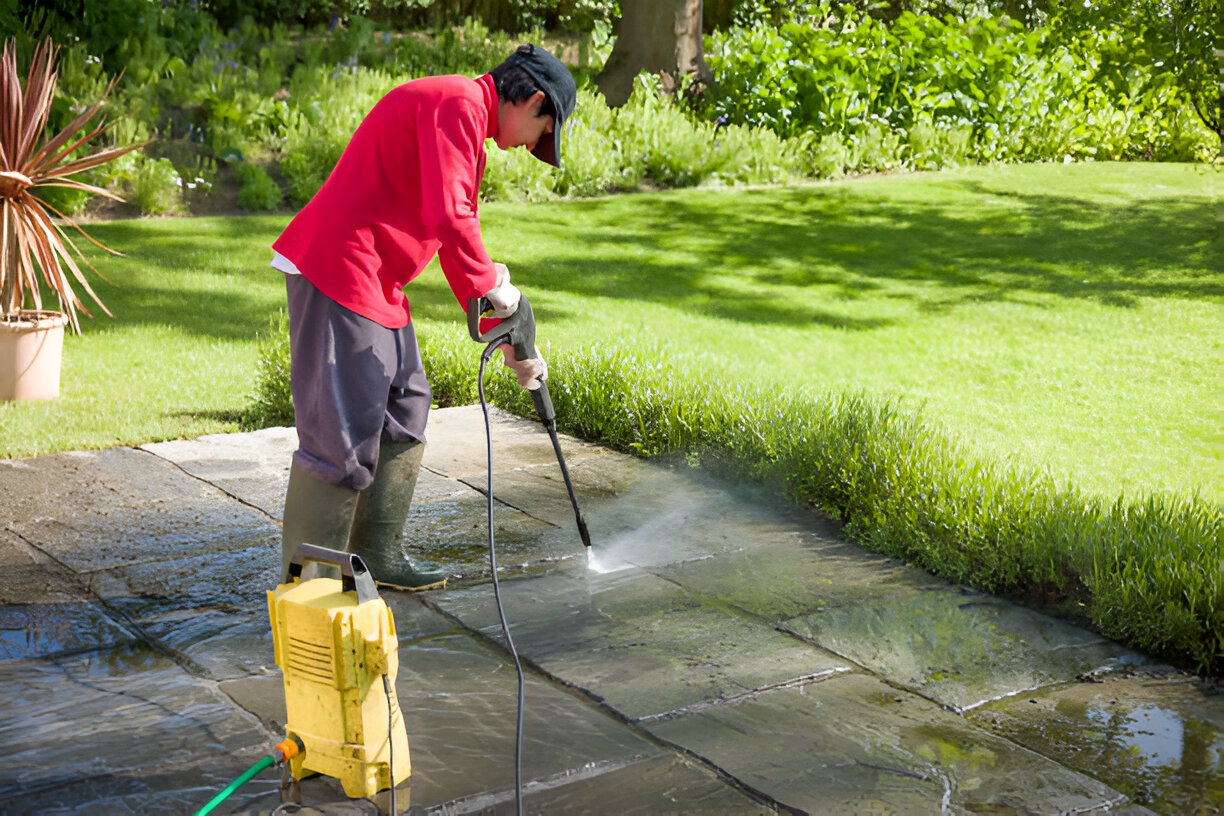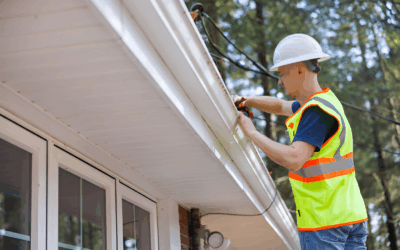Summer in Chesapeake, Virginia, brings sunny barbecues, family gatherings, and relaxing evenings on the patio. But before the festivities begin, it’s important to make sure your concrete patio is spotless, safe, and ready to impress. At Hampton Roads Powerwashing, we know that proper patio prep involves more than just a quick sweep—it requires expert cleaning, protective sealing, and strategic maintenance to withstand Chesapeake’s coastal climate and humidity.
Why Summer Prep Is Essential for Your Concrete Patio in Coastal Virginia
Impact of Chesapeake’s Humid Climate on Concrete
Chesapeake’s humid coastal climate can be tough on concrete surfaces. High humidity and salt air accelerate wear and tear, causing surfaces to become slippery, stained, or cracked. Without proper care, mold and mildew can thrive, reducing your patio’s lifespan and safety.
Preventing Mold, Mildew, and Surface Deterioration
Mold and mildew aren’t just unattractive—they’re hazardous. Moisture trapped in concrete pores fosters microbial growth, leading to unsightly stains and potential health risks. A good summer prep strategy helps prevent these issues before they start.
Boosting Aesthetic Appeal Before Entertaining
A freshly cleaned and sealed patio sets the tone for your summer events. Whether you’re hosting a cookout or an evening gathering, a spotless, well-maintained surface enhances your home’s curb appeal and makes a lasting impression on guests.
Step-by-Step Patio Cleaning Tips Before Summer
Sweep and Rinse the Surface First
Begin by removing loose dirt, leaves, and debris using a stiff-bristled broom. Follow this with a garden hose rinse to loosen surface-level grime.
Use a Pressure Washer: Dos and Don’ts
Pressure washing is one of the most effective ways to deep-clean your concrete. Use a fan tip to avoid surface damage, and maintain a consistent motion to prevent streaking. Avoid holding the nozzle too close to the surface, which can etch the concrete.
Recommended Pressure Settings for Concrete Patios
A pressure setting between 2,500–3,000 PSI is generally safe for concrete patios. Always test a small area first, and adjust pressure as needed depending on surface wear and age.
Eco-Friendly Cleaners Safe for Plants and Pets
Opt for biodegradable concrete cleaners that are safe for nearby plants and pets. Avoid bleach-based products that may harm grass or gardens surrounding your patio.
How to Remove Stains and Rust From Your Concrete
Identifying Rust, Oil, and Mold Stains
Rust often appears as reddish-brown streaks, while oil stains are typically dark and greasy. Mold and mildew show up as black or green patches. Identifying each correctly ensures you use the right removal technique.
DIY Rust Removal vs. Hiring a Rust Removal Company in Chesapeake
While light rust stains can be tackled with lemon juice or vinegar, deeper stains often require professional treatment. Hiring a rust removal company in Chesapeake ensures efficient, damage-free results.
Using a Pressure Washer for Rust Removal
For mild rust stains, pressure washing paired with a rust-dissolving cleaner can be effective. However, it’s important not to over-wash the same area, as this can damage the concrete surface over time. When in doubt, consider hiring a professional rust cleaning service to ensure safe and thorough removal without compromising your patio’s integrity.
Why You Should Avoid Harsh Acid Cleaners
Acid-based cleaners, while effective, can erode the surface and damage nearby landscaping. Use them with caution, or better yet, opt for professional-grade eco-safe alternatives.
Applying Sealant to Protect Your Concrete Surface
Benefits of Concrete Sealant in Chesapeake’s Weather
Sealants create a protective barrier against moisture, UV rays, and stains. In Chesapeake’s damp climate, sealing your patio helps prevent cracking, pitting, and mildew growth.
Choosing the Right Sealant Type (Acrylic, Penetrating, etc.)
- Acrylic Sealers: Enhance appearance with a glossy finish, suitable for decorative patios.
- Penetrating Sealers: Ideal for patios prone to water exposure, as they provide deep protection without altering the surface look.
When and How to Reapply Sealant for Maximum Protection
Sealant should be reapplied every 2–3 years or when water no longer beads on the surface. Always clean and allow the surface to dry thoroughly before sealing.
Cure Time and When It’s Safe to Use Again
Most sealants require 24–48 hours to cure completely. Avoid placing furniture or walking on the surface until it’s fully cured to ensure optimal bonding and longevity.
Patio Safety Guidelines Before Entertaining
Non-Slip Coatings for Wet Concrete
If your patio becomes slick when wet, consider adding a non-slip additive to your sealant. This enhances safety without altering the patio’s appearance.
Checking for Cracks and Uneven Surfaces
Inspect for visible cracks or trip hazards. Small cracks can be sealed with concrete filler, while uneven surfaces may require grinding or professional repair.
Keeping Grills and Firepits Safe on Sealed Concrete
To protect your concrete patio from heat damage and staining, Hampton Roads Powerwashing recommends using a heat-resistant mat or paver base under grills and firepits. It’s also essential to maintain proper ventilation and ensure safe clearance from any combustible materials for a worry-free outdoor experience.
Proper Furniture Placement to Avoid Surface Damage
Avoid dragging heavy furniture across the patio. Use protective pads under table and chair legs to prevent scratches or gouges.
Chesapeake-Specific Tips for Outdoor Hosting
Best Times for Outdoor Parties in Coastal Virginia
Early evenings in June or late mornings in September often provide the most comfortable temperatures and fewer bugs. Always check humidity and weather forecasts before planning.
Summer Pest Prevention Tips
Use citronella candles, plant natural repellents like lavender or mint nearby, and eliminate standing water to reduce mosquito activity.
Local Water Usage Restrictions (if any)
Check with Chesapeake’s local authorities for any summer water restrictions. Use rainwater collection systems when available for outdoor cleaning and irrigation.
Heat & UV Protection for Furniture and Guests
Set up umbrellas, shade sails, or pergolas to protect guests and patio furniture from direct sun. UV-resistant covers and cushions also prolong the life of your outdoor setup.
Maintenance Schedule for a Summer-Ready Patio
Weekly, Monthly & Seasonal Cleaning Checklist
- Weekly: Sweep debris, check for stains.
- Monthly: Rinse down the patio, inspect for signs of wear.
- Seasonally: Deep clean, reseal (if needed), safety inspection.
Signs It’s Time for Re-sealing or Pressure Washing
If your concrete looks dull, absorbs water, or shows signs of mold, it’s time for resealing or another round of pressure washing.
How Long Patio Sealants Last in Humid Environments
In humid areas like Chesapeake, sealants tend to break down faster due to constant moisture exposure. Expect to reseal every 2–3 years depending on wear and usage.
Common Mistakes to Avoid in DIY Patio Prep
- Using high-pressure settings on old or decorative concrete
- Applying sealant over damp surfaces
- Skipping safety gear when pressure washing
- Ignoring cracks until they worsen
Final Checklist: Is Your Patio Summer-Ready?
Quick Pre-Event Inspection Guide
- Surface is clean and stain-free
- No cracks or uneven areas
- Sealant fully cured
- Furniture and décor are in place
Safety, Cleanliness, and Appearance Checks
Ensure walking paths are clear, lighting is adequate, and all surfaces are dry before your guests arrive.
Add Final Touches Like Lighting, Decor, and Seating
Enhance ambiance with string lights, potted plants, and cozy outdoor furniture. Add pillows and throws for extra comfort and style.
Conclusion
Preparing your concrete patio for summer entertaining in Chesapeake, VA, doesn’t have to be overwhelming. With the right approach to concrete cleaning, sealing, and safety maintenance, you can enjoy a clean, durable, and inviting outdoor space all season long. Whether you prefer a DIY solution or rely on local professionals, proper preparation is the key to creating a relaxing summer oasis.
Need help getting started? Contact your trusted concrete cleaning and sealing experts in Chesapeake to make sure your patio is ready for every sunny celebration.
Frequently Asked Questions (FAQs)
Q1. How often should I pressure wash my concrete patio in Chesapeake, VA?
A: Ideally, you should pressure wash your concrete patio at least once a year—preferably before summer. However, if your patio is shaded or prone to mold and mildew, consider washing it twice a year for best results.
Q2. Is sealing my patio necessary every year?
A: Not necessarily. Most high-quality sealants last between 2–3 years, depending on weather exposure and foot traffic. You can perform a water-bead test to check—if water soaks into the surface rather than beading up, it’s time to reseal.
Q3. Can I use household cleaners on my concrete patio?
A: While mild dish soap or baking soda can help with general cleaning, avoid harsh chemicals like bleach or ammonia as they can damage the surface and harm surrounding plants. Opt for eco-friendly concrete cleaners for best results.
Q4. What’s the best time of day to clean or seal my patio?
A: Mornings or late afternoons on dry, overcast days are ideal. Avoid working during peak sun hours as rapid drying can lead to streaking or improper sealant application.
Q5. Do I need to move furniture before sealing?
A: Yes, all furniture, planters, rugs, and grills should be removed from the patio surface before cleaning or sealing. This ensures complete coverage and helps prevent uneven curing or staining.



